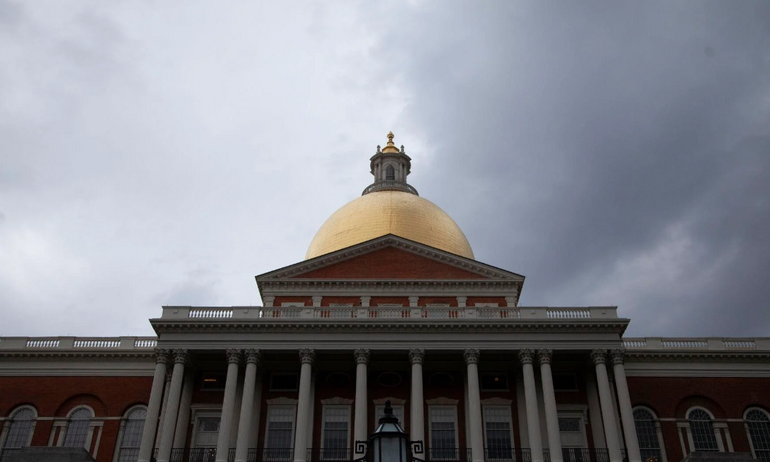The account used to pay unemployment insurance benefits in Massachusetts is on track to run out of money by the end of 2027, according to a new forecast that could increase pressure on Beacon Hill to enact systemic changes before or during an election year.
With benefit payments and debt owed to the federal government continuing to outpace what the state collects from employers, the Executive Office of Labor and Workforce Development now projects that the unemployment insurance trust fund will tilt into the red in less than two and a half years.
The latest quarterly report published this week, which uses a higher unemployment rate forecast for the coming years, estimates the account will end 2027 with a shortfall of about $134 million.
That’s an earlier dropoff than in a prior report released in April, which estimated the account would dip into the red in the first quarter of 2028, rebound a bit and then end the year with a negative balance.
Officials continue to project taxes on businesses used to fund unemployment benefits will increase every year until 2028, when they will reach the highest possible level. In addition to rate adjustments, the state can borrow money to replenish the unemployment fund and keep benefits paid. During the COVID-19 pandemic, Massachusetts took out federal advances, then issued bonds to spread repayment costs over multiple years.
The new report forecasts that Massachusetts will pay hundreds of millions of dollars more in unemployment benefits across 2026, 2027 and 2028 than previously estimated. Its calculations are built on an assumption that unemployment will hover around 4.5% in the next five years, up from the roughly 3.7% rate baked into the prior quarterly report.
Tufts University Center for State Policy Analysis Executive Director Evan Horowitz criticized prior state projections as relying on an overly optimistic unemployment forecast. He said Monday that he’s “glad we’ve finally acknowledged the obvious reality that unemployment isn’t going to be low forever.”
“Now lawmakers need to face the equally obvious fact that our system is broken,” he said. “In a few years, we’re likely to see an unholy mix of high headline tax rates and even higher benefit costs, leading to large and persistent shortfalls. That’s bad.”
Employers pay different amounts based on how many of their former workers collect unemployment benefits and how much they have set aside to cover unemployment costs. Right now, those contributions are assessed at what the state calls “Schedule D,” the middlemost rung.
An employer can expect to pay between $124.50 and $1,897.50 per employee per year under Schedule D, according to a report by the Massachusetts Taxpayers Foundation. Under the highest-possible Schedule G the state expects to hit by 2028, that per-employee cost range would increase to between $181.50 and $2,782.50 — a roughly 45% increase stretching across a statewide election and the start of the next gubernatorial term.
Many business groups have been pushing the Legislature to overhaul the unemployment system, arguing that the state offers some of the most generous benefits in the country and that the costs on employers hamstring competitiveness.
In January, the Healey administration pledged to convene business, labor and other leaders and chart a path toward major reforms. The talks have not yet produced any major changes to eligibility or benefit levels.
The administration has made other changes to overhaul UI technology and pilot extended call center hours, promoting those as making the system more efficient for users.
Jay Ash, the former housing and economic development secretary to Gov. Charlie Baker who now leads the Massachusetts Competitive Partnership, warned last week that the state’s “UI system is broken.”
“We consistently rank at or near the bottom on cost, and it is just another reason that MA has an anti-competitive reputation,” he wrote in a LinkedIn post. “The Administration and the Legislature are pledging to examine the system closely – here’s hoping they do so and make reforms that make it easier to afford to hire our residents.”
Ash pointed to CNBC’s latest “Top States for Business” list published in June, which ranked Massachusetts 20th overall. The Bay State earned high marks for education, quality of life, and technology and innovation, but landed at 49th in “cost of doing business.”
In addition to benefits, businesses are also paying an additional charge to pay back pandemic-era borrowing the state undertook to replenish the trust fund. The employer-funded account will be on the hook for an additional $203 million per year to repay the federal government for a Baker administration accounting error that used federal funding to pay benefits the state should have covered.
The first payment is due by Dec. 1 under an agreement Gov. Maura Healey’s deputies negotiated, which waived some fees and liabilities Massachusetts might have otherwise faced.
A coalition of influential organizations called the Massachusetts Opportunity Alliance launched a campaign in March calling on Beacon Hill to use state dollars for that repayment, not the unemployment insurance trust fund.
Lawmakers have in the past intervened to freeze looming unemployment tax rate increases. They tend to take up economic development-related legislation in the second year of the two-year cycle, when all 200 legislative seats are up for reelection. Healey plans to seek reelection in 2026, and has so far drawn two Republican challengers.

